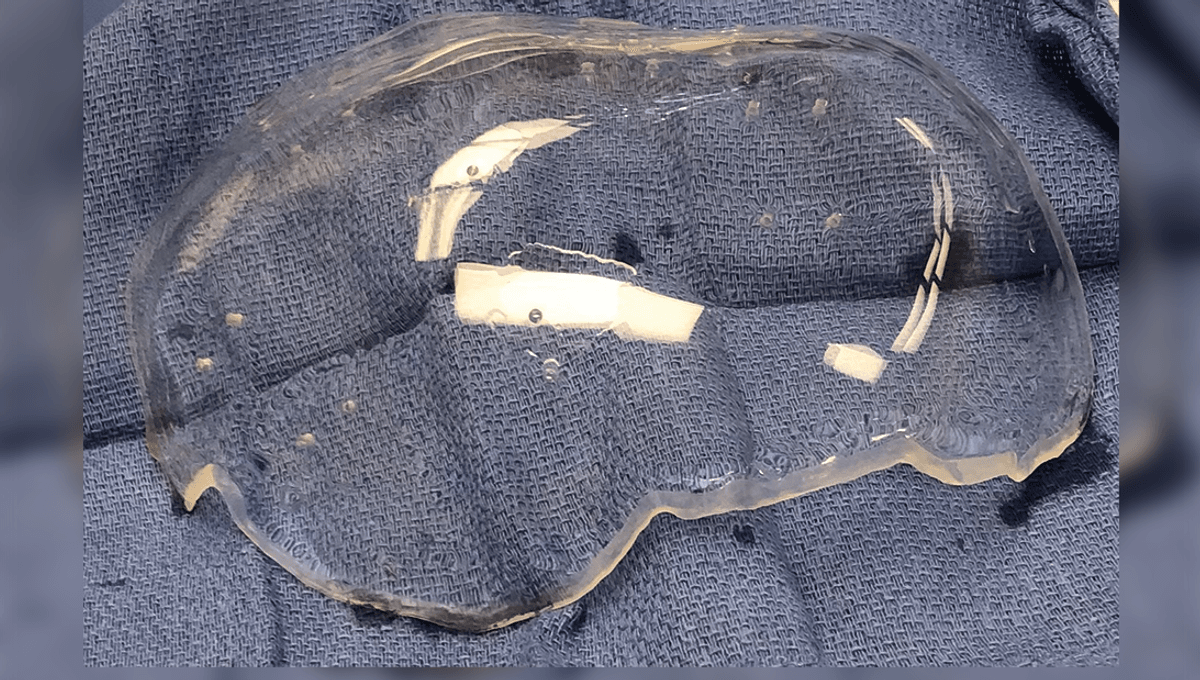
In a world first, scientists have literally opened a window into the human brain. They inserted a transparent panel into the skull of a patient and were able to collect high-resolution imaging data through it while the patient was awake and performing tasks, the first time such a feat has been achieved.
The patient who volunteered for this pioneering study was 39-year-old Jared Hager, who suffered a traumatic brain injury (TBI) during a skateboarding accident in 2019. As is quite common in such cases, part of Hager’s skull had to be surgically removed to give space for the brain tissue to swell as it healed.
Because of delays during the COVID-19 pandemic, Hager was unable to have a prosthesis installed to repair the skull for over two years – definitely not ideal, but if you’re of the “when life gives you lemons, make lemonade” school of thought, clearly a good opportunity to try out some experimental brain imaging.
While awaiting surgery, Hager volunteered for a research project run by Charles Liu, a professor at the Keck School of Medicine and director of the USC Neurorestoration Center, in collaboration with colleague Jonathan Russin and a team at Caltech. When the time came for Hager’s prosthesis surgery, he again teamed up with the scientists, who by this time were investigating a novel technique called functional ultrasound imaging (fUSI).
Compared with something like an MRI scan, ultrasound is cheaper, more portable, and more comfortable for the patient. You also have to lie very still in an MRI machine, whereas with ultrasound you can collect data while people are taking part in normal activities.
Patients with TBI often develop neurological issues, including dementia, so it is hoped that fUSI could be a way of monitoring this. “If we can extract functional information through a patient’s skull implant, that could allow us to provide treatment more safely and proactively,” Liu explained in a statement.
The snag is that fUSI doesn’t work through a conventional skull prosthesis. That’s where this idea of a transparent window came in. Made of polymethyl methacrylate – a bit like plexiglass – it served the dual purpose of repairing Hager’s skull while also allowing brain imaging data to be collected. The whole piece of plastic was 4 millimeters thick, with a 2-millimeter-thick section to give the ultrasound transducer access to the brain’s parietal and motor cortices.
“This area of the brain, which is important for forming intentions and carrying out motor actions, has already been thoroughly studied via other methods in our lab,” explained Professor Richard Andersen, part of the team at Caltech, in another statement.
The team had already done some modeling, as well as experiments on rats, to try out different types of implants and to hone the fUSI parameters in order to get optimal results. Primate data had proven the technique could provide useful information. Now, it was time to try it on a human.
Before and after the surgery, Hager was asked to solve a “connect-the-dots” puzzle on a computer and to play some tunes on his guitar while the ultrasound was performed. The key question was whether fUSI would still be accurate and precise when done through a clear plastic window.
“The fidelity of course decreased, but importantly, our research showed that it’s still high enough to be useful. And unlike other brain-computer interface platforms, which require electrodes to be implanted in the brain, this has far less barriers to adoption,” Liu said.
Not only does having a window installed in your brain allow for nifty experiments like this, it might actually be better for patients in the long run, as Russin explained: “One of the big problems when we do these surgeries is that a blood clot can form underneath the implant, but having a clear window gives us an easy way to monitor that.”
If more people were to be offered this alternative prosthesis, it could allow scientists to gather useful data about TBI outcomes on a broader scale. Clinical trials would be needed before the technology could be rolled out more widely, and more studies are needed to build on the data gathered from Hager.
“Jared is an amazing guy,” Liu enthused. “His contributions have really helped us explore new frontiers that we hope can ultimately help many other patients.” This work has already begun, with attention turning to other experimental technologies like laser spectroscopy.
“What our findings [show] is that we can extract useful functional information with this method,” said Liu. “The next step is: What specific functional information do we want, and what can we use it for?”
The study is published in Science Translational Medicine.
Source Link: World-First Clear Plastic Skull Implant Opens A Window (Literally) To The Human Brain